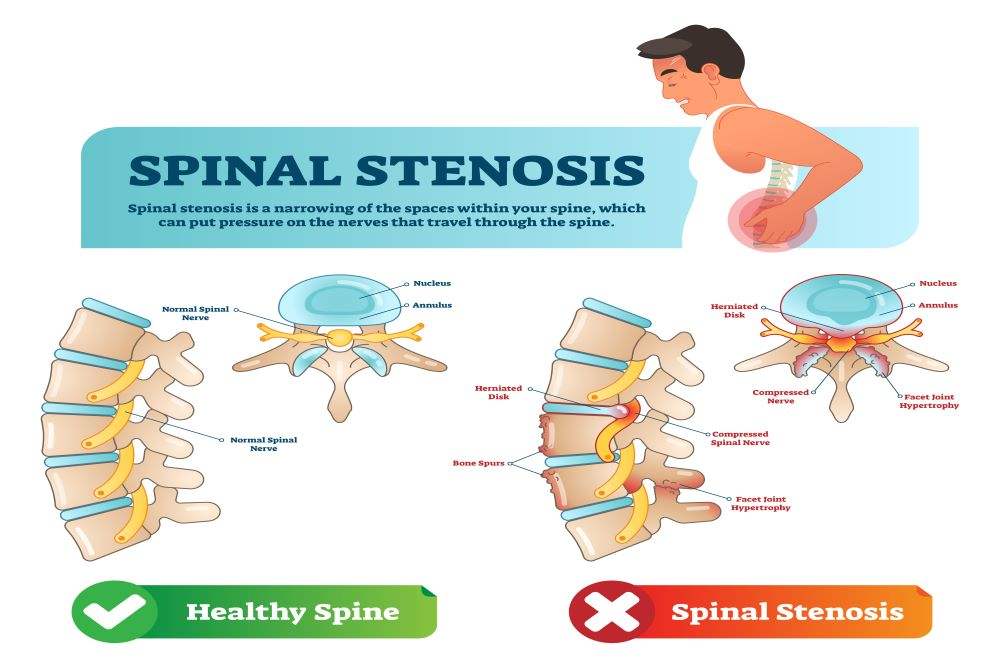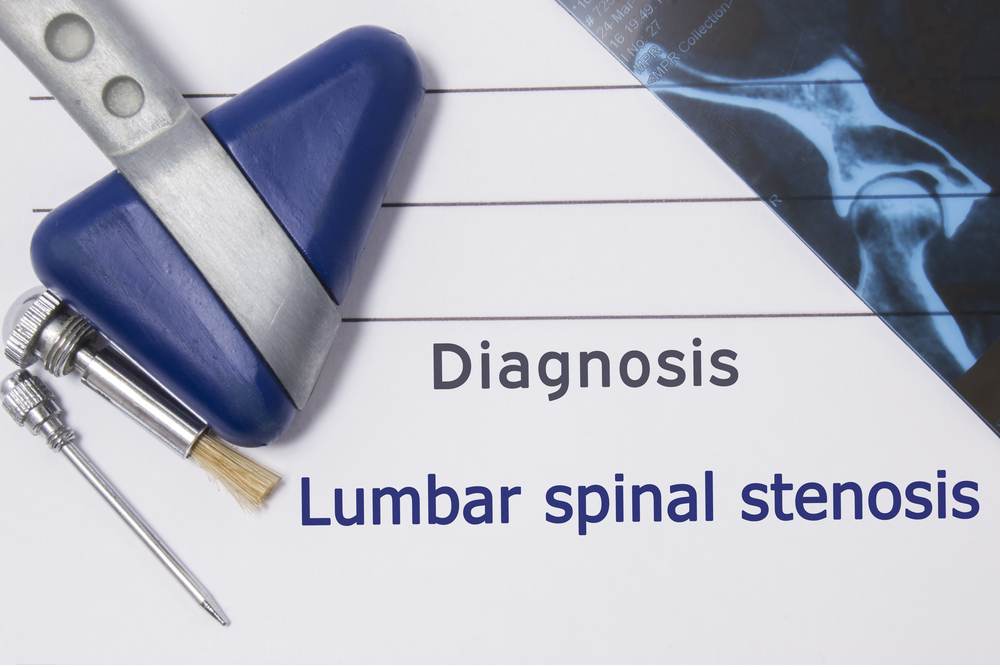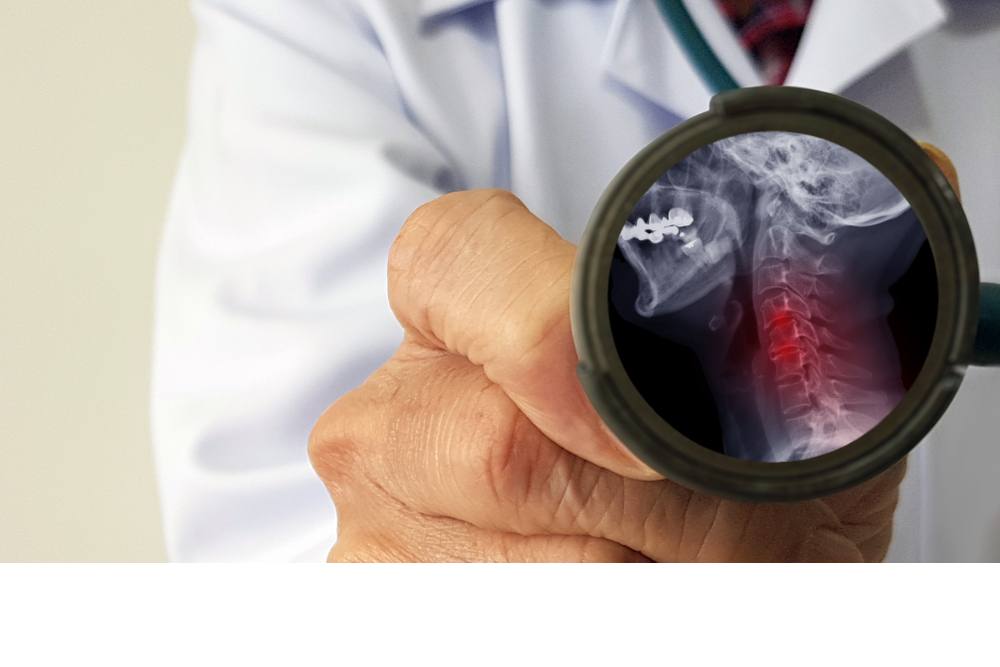Your spine is made up of bones called vertebrae stacked on top of each other that support and stabilize your upper body. There are also small openings in the vertebrae where spinal nerves run through and connect your brain to the rest of the body, known as the spinal cord. Muscles and other soft tissues surround and support your spine so you can engage in everyday movements like walking, balancing, turning, and twisting. A condition like spinal stenosis means that the space in and around your vertebrae narrows, negatively impacting the spinal cord. This condition can occur gradually, which means you might not notice symptoms at first until it starts to cause problems. However, there are certain signs and symptoms to look out for so you can see your doctor or chiropractor and minimize the negative effects of spinal stenosis.
What Is Spinal Stenosis?
 Spinal stenosis refers to a narrowing of the spinal column, which comprises 33 vertebrae divided into three main sections: the cervical, thoracic, and lumbar spine. Your spinal column refers to your spine’s bones and skeletal structure, while the spinal cord refers to the nerves that make up part of the central nervous system. When spinal stenosis occurs, the spinal column starts to narrow, putting pressure on the spinal cord. The two most common places for spinal stenosis to occur are in your neck and lower back.
Spinal stenosis refers to a narrowing of the spinal column, which comprises 33 vertebrae divided into three main sections: the cervical, thoracic, and lumbar spine. Your spinal column refers to your spine’s bones and skeletal structure, while the spinal cord refers to the nerves that make up part of the central nervous system. When spinal stenosis occurs, the spinal column starts to narrow, putting pressure on the spinal cord. The two most common places for spinal stenosis to occur are in your neck and lower back.
Cervical Spinal Stenosis
The cervical spine refers to the first seven vertebrae of the spine located in your neck. We depend on the cervical spine to support and provide mobility to the head. Common movements like nodding or turning your head side to side depend on healthy flexion and extension in the cervical spine. When the narrowing occurs in your neck, the passageway for spinal nerves in your vertebrae can become compressed and cause uncomfortable symptoms in your neck, shoulders, arms, and hands. Your cervical spinal stenosis symptoms can differ depending on what vertebrae are affected. For example, the nerves in the C6 vertebra control the biceps in your arms, while the C7 vertebra and nerves control your triceps.
Lumbar Spinal Stenosis
The lumbar spine refers to the largest part of your spine in your lower back and is made up of 5 vertebrae. The vertebrae in your lumbar spine are also thicker and like building blocks that provide stability for your back and spine. This area of the spine helps support most of your body’s weight and is where your center of balance is located. You depend on your lumbar spine to support the upper body and help it move in all different directions. Spinal stenosis of the lumbar spine is the most common location for this condition and can make movements like walking, sitting, and standing uncomfortable.
Causes of Spinal Stenosis
Degeneration
The most common cause of spinal stenosis is the natural aging process. The body experiences a lot of wear and tear throughout your life. As you age, soft tissues like muscles and ligaments that support your spine can start to thicken. Your bones might get bigger, and surrounding tissues can cause you to lose the flexibility you once had. Wear and tear on the spine over the years can lead to degeneration, which is a term used to describe the gradual loss of effectiveness and functioning. As vertebrae and the spinal discs that separate them undergo wear and tear, they can start to break down and lose their support.
Health Conditions
Certain health conditions can trigger or contribute to the effects of spinal stenosis. The most common form of arthritis, called osteoarthritis, causes the cartilage in joints to break down. Osteoarthritis in the spine can affect cartilage between vertebrae and trigger the growth of bone spurs on the spine. Other types of arthritis can also lead to the growth of bone spurs, which can also put pressure on spinal nerves. Abnormal tissue growth like spinal tumors can also trigger inflammation and lead to narrowing of the spine. Genetic conditions and certain bone diseases like congenital spinal stenosis, achondroplasia, and scoliosis can also trigger spinal and neurological abnormalities.
Spinal Injuries
A sudden injury to the spine can also cause spinal stenosis to occur. A slipped disc can put pressure on the nerves in your spine, or trauma from a car accident can result in displaced bones and tissues. These both lead to too much pressure on your nerves and spinal cord. A slip and fall accident can cause a spinal injury that can damage your neck or lower back. The trauma from a car accident, sports injury, or slip and fall accident can cause the spine to narrow and put pressure on nerves that send signals throughout the body, like to your arms and legs.
Symptoms of Spinal Stenosis
You will typically start to experience symptoms of spinal stenosis gradually as the nerves become more and more compressed due to the narrowing of the spinal column. Common symptoms include pain, tingling, and numbness that extend into your extremities. Cervical spinal stenosis can cause shooting pain, tingling sensations, or numbness in your shoulders, arms, and hands. You may also notice weakness in your arms, and certain movements might become more uncomfortable. Lumbar spinal stenosis can lead to lower back pain, especially when you move from sitting to standing or while walking for long periods of time. Spinal stenosis in your lower back can also cause numbness in your buttocks and legs. Pain and tingling can extend into your legs and feet. One type of pain caused by spinal stenosis is called sciatica, which is when the sciatic nerve in your lower back becomes aggravated or compressed. Lumbar spinal stenosis can also cause issues with balance depending on the severity and what nerves are affected. In more advanced cases of spinal stenosis, you may experience loss of bowel or bladder control.
How Is Spinal Stenosis Diagnosed?
 To diagnose spinal stenosis, your doctor will likely use a combination of a physical examination and diagnostic imaging tools. A physical exam will allow your doctor to look for visible signs of spinal stenosis and assess for weakness in certain areas. Your doctor will also want to check for any abnormal reflexes that a condition like spinal stenosis may impact. Imaging tests like X-rays, a CT scan, or an MRI will provide your doctor with detailed images of the affected area. X-rays are commonly used to diagnose injuries and issues that impact the skeletal system. Your doctor may request a CT scan or MRI for a more detailed look at surrounding tissues like muscles, ligaments, and spinal discs. These diagnostic imaging tools provide detailed images of your spinal canal and nerve structures to help determine the cause of your symptoms and diagnose a condition like spinal stenosis. In some cases, your doctor may also request a bone scan to check for any problems like infection, bone cancer, or other tumors. An electromyogram will test the health of your spinal nerves and provide additional information to support a diagnosis like spinal stenosis.
To diagnose spinal stenosis, your doctor will likely use a combination of a physical examination and diagnostic imaging tools. A physical exam will allow your doctor to look for visible signs of spinal stenosis and assess for weakness in certain areas. Your doctor will also want to check for any abnormal reflexes that a condition like spinal stenosis may impact. Imaging tests like X-rays, a CT scan, or an MRI will provide your doctor with detailed images of the affected area. X-rays are commonly used to diagnose injuries and issues that impact the skeletal system. Your doctor may request a CT scan or MRI for a more detailed look at surrounding tissues like muscles, ligaments, and spinal discs. These diagnostic imaging tools provide detailed images of your spinal canal and nerve structures to help determine the cause of your symptoms and diagnose a condition like spinal stenosis. In some cases, your doctor may also request a bone scan to check for any problems like infection, bone cancer, or other tumors. An electromyogram will test the health of your spinal nerves and provide additional information to support a diagnosis like spinal stenosis.
Treatment Options for Spinal Stenosis
 Once your doctor has determined a diagnosis of spinal stenosis, they will walk you through your treatment options. In mild cases of spinal stenosis, your doctor may recommend certain medications to help manage pain and related symptoms. However, the treatment for your spinal stenosis will depend on how far the condition has progressed. While there is no cure for spinal stenosis, many of the following treatment options can help reduce your symptoms and slow the progression of the condition.
Once your doctor has determined a diagnosis of spinal stenosis, they will walk you through your treatment options. In mild cases of spinal stenosis, your doctor may recommend certain medications to help manage pain and related symptoms. However, the treatment for your spinal stenosis will depend on how far the condition has progressed. While there is no cure for spinal stenosis, many of the following treatment options can help reduce your symptoms and slow the progression of the condition.
Home Remedies
You can find relief with at-home remedies for some symptoms of spinal stenosis. Typically, your doctor will recommend home remedies in conjunction with other treatment options to help you experience the most relief. Alternating with cold compresses and heating pads can bring temporary relief for pain, swelling, and stiffness. Applying cold compresses will help reduce swelling and inflammation that might worsen your pain. A heating pad or warm bath can help soothe stiff, aching muscles and help you relax. Other home remedies for back pain can include oils and ointments to help block pain sensations.
Chiropractic Care
Chiropractic care can help correct and realign your vertebrae, which helps reduce pressure on the nerves in your spinal cord. Chiropractors take an all-natural and non-invasive approach to pain relief and addressing health conditions like spinal stenosis. Chiropractic care can include a variety of techniques, like spinal adjustments, therapeutic massage, and soft tissue mobilization. Your chiropractor will develop a personalized plan to address your specific symptoms and help slow the progression of your spinal stenosis.
Physical Therapy
Regular stretching and exercise can help reduce the effects of spinal stenosis. A physical therapist can provide you with effective strategies for managing your spinal stenosis symptoms and help you improve your strength and mobility. Physical therapy activities will help you improve your balance and flexibility so you can engage in your regular activities again. Stretching and strengthening exercises also work to provide your spine with greater stability and support. Exercises and activities with a physical therapist can also improve strength in your core, arms, and legs to improve overall healthy functioning. Physical therapy can also help you manage and relieve your pain and other symptoms if you have to get a more invasive procedure to help with spinal stenosis, like surgery.
Assistive Devices
Your doctor or physical therapist can also help you utilize assistive devices that can help reduce your symptoms while you go about your day. Back and neck braces can help lessen muscle tension and reduce your range of motion while you heal from a recent injury. Braces can also help restrict painful movements when engaging in certain activities. Older adults who experience spinal stenosis and difficulties with balance can also benefit from an assistive device like a walker to help them move around safely.
Types of Surgery
If you are dealing with severe symptoms of spinal stenosis, your doctor may recommend surgical options to help reduce your discomfort. Depending on its location and severity, many different types of surgery can help with spinal stenosis. A doctor may recommend surgery when spinal stenosis starts to impact your ability to do routine activities or affects control of your bowel or bladder. A laminectomy is the most common type of surgical intervention that can help with spinal stenosis. This involves the surgeon removing part of a vertebra to create more room for the nerves. Other types of surgery for spinal stenosis may include a foraminotomy to widen the spine or a spinal fusion to help where multiple parts of the spine are involved. Talk to your doctor about all your treatment options and the long-term outlook to help determine if surgery or other options are right for you.
Preventing Spinal Stenosis
While you cannot completely prevent a condition like spinal stenosis from occurring, you can take steps to support your overall strength, health, and wellness. You can lower your risk of developing spinal stenosis by keeping your spine healthy. Regular exercise will help maintain strong and healthy muscles that support your back and keep your spine flexible. Aerobic activities typically associated with heart and lung health also have major benefits to spine and nerve health. Practicing good posture will also help reduce the risk of injury to your spine. Learn how to lift heavy objects safely without damaging your back and practice good posture while sitting at your desk or driving your car for long periods of time. Maintaining a healthy weight will also help reduce stress on your back and support overall health and wellness.
If you are experiencing symptoms of spinal stenosis, visit AICA Orthopedics in Lithia Springs for quality, personalized attention, and care. Our team of doctors offers consultations, diagnoses, and treatment for all kinds of spinal issues and injuries. We have orthopedic doctors, neurologists, chiropractors, and physical therapists all in one convenient location so you can receive comprehensive and personalized care.
